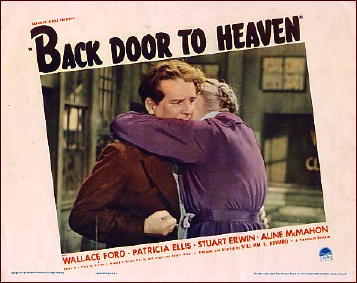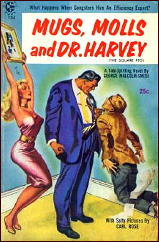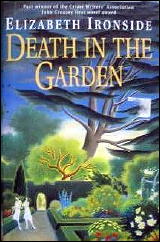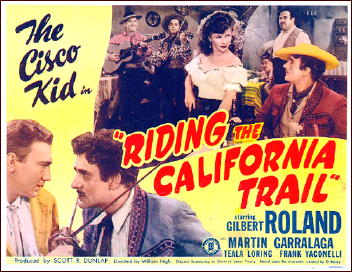November 2010
Monthly Archive
Wed 24 Nov 2010
REVIEWED BY WALTER ALBERT:
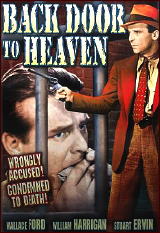
BACK DOOR TO HEAVEN. Paramount, 1939. Wallace Ford, Patricia Ellis, Aline McMahon, Stuart Erwin, Van Heflin, Bert Frohman, George Lewis, Bruce Evans, James Lydon. Director: William K. Howard. Shown at Cinefest 28, Syracuse NY, March 2008.
This low-budget production had some promise with the superior cinematography of Hal Mohr, a good cast, and the experienced direction of William K. Howard.
However, the grim, downward spiral of the fortunes of a poor but decent kid gone wrong (played by Jimmy Lydon, with Wallace Ford portraying him as an adult) climaxed in a scene bathed in a synthetic pathos that undid much of the gritty, late Depression realism of the film.
An overwrought score by Erno Rapee constantly undercut the director’s restraint in the handling of a script based on his original story and personal experiences. This film continued what seems to be a tradition at Cinefest of disappointing openings.
Tue 23 Nov 2010
SPECIAL INVESTIGATOR. RKO Radio Pictures, 1936. Richard Dix, Margaret Callahan, J. Carrol Naish, Erik Rhodes, Sheila Terry, Jed Prouty, Ray Mayer, Owen Davis Jr. Based on the story “Fugitive Road” by Erle Stanley Gardner. Director: Louis King.
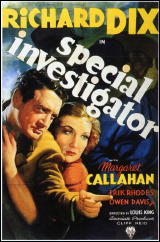
As far as I’ve been able to determine, the story “Fugitive Road†this action-packed B-movie is based on was serialized in This Week Magazine between 26 May and 7 July 1935. This was a small snippet of info I found on the Internet, and without any supporting evidence, I don’t think we ought to take it as unadulterated fact.
My Gardner bibliography is buried somewhere. If anyone can corroborate this, and even better, let me know if the story was ever reprinted anywhere, be sure to let me know.
Unfortunately I don’t think long runs of This Week Magazine are floating around any place easily accessible, and if it’s never been reprinted, good luck on ever reading this one.
It’s a good story, though, assuming that the adaptation into the movie Special Investigator followed it even partially. What’s more, I think I’ve found the perfect actor to play the 1930s version of Perry Mason to a T: Richard Dix, square-jawed and resolute, whose most recent (and only other) film to have been reviewed on this blog was The Arizonian, a western in which (as you may recall) he played a Good Guy who comes to town to wipe out the Bad Guys.
But in Special Investigator Dix plays Bill Fenwick, a high-powered L.A. defense attorney who’s lately been making a big name for himself getting even bigger criminal names walk free. But when tragedy strikes, and it does, his gives up both his practice and his girl friend (Sheila Terry), and goes undercover in a small town in Nevada, this time on the right side of the law.
Along the way he meets – and falls in love with – another girl (Margaret Callahan), a spirited young lady who just happens to be tied in with the gang of crooks he’s determined to bring to justice. (Isn’t that always the way?)
In a movie that times in at just over an hour’s running time, there’s as much action in Special Investigator as any B-western of the same era, straight and simple. There’s a minimum of actual detection, but on the other hand, there’s an equal minimum of funny sidekicks to have to deal with too.
Recommended.
Tue 23 Nov 2010
Posted by Steve under
ReviewsNo Comments
REVIEWED BY GEOFF BRADLEY:
ANDREW GARVE – A Press of Suspects. Collins Crime Club, UK, 1951. Fontana, UK, paperback, 1956. US title: By-Line for Murder. Harper, hardcover, 1951. Paperback reprints: Dell #765, 1954; Lancer 72-715, 1964.
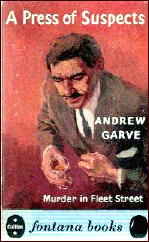
I happened upon this early Garve by chance, and as he is a writer I have always wanted to read more of, I picked it up and got straight to it.
Set in a Fleet Street newspaper office — a setting familiar to Garve who was, in real life a journalist — it concerns the Assistant Foreign Editor who, annoyed at being overlooked for promotion, yet again, decides to wreak revenge on all those he considers to be looking down on him by the indiscriminate use of cyanide.
Don’t worry (those of you who get concerned at the possibility that I reveal too much in my summaries), this is a procedural not a whodunit and we are made aware of the villain’s actions right from the start. We share the thoughts and actions of many of the main protagonists including Inspector Haines, the man from Scotland Yard called in to investigate after the first death.
At one stage Haines describes his methods as humdrum, and in a way that’s what the book is as the story unfolds in a very matter-of-fact way, but it retains the attention and I found myself engrossed until, with a sigh of satisfaction, the final page was read.
I shall certainly be looking for more of Andrew Garve while I am browsing the shelves of the dwindling number of second-hand bookshops that I get to visit.
Previously on this blog —
A Hole in the Ground (reviewed by Ray O’Leary)
A Touch of Larceny, a film based on The Megstone Plot (reviewed by David L. Vineyard)
Editorial Comment: According to Al Hubin, this was the only case solved by Inspector Haines to have appeared in print.
Tue 23 Nov 2010
Posted by Steve under
Reviews[4] Comments
IT IS PURELY MY OPINION
Reviews by L. J. Roberts
COLIN COTTERILL – Thirty-Three Teeth. Soho Crime, hardcover, August 2005; trade paperback, August 2006.
Genre: Licensed investigator/Paranormal. Leading character: Dr. Siri Paiboun; 2nd in series. Setting: Laos–Contemporary/1977.
First Sentence: The neon hammer and sickle buzzed and flickered into life over the night club of the Lan Xang Hotel.
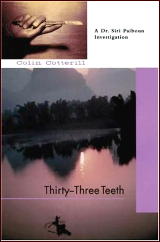
It is 107 degrees in Vietiane, Laos where the standard greeting and response has become, “Hot, isn’t it.†“Damned hot.â€
Dr. Siri Paiboun, the 72-year-old coroner for Laos, is being kept busy by both the spirit and human world. An old black mountain bear has escaped its cage but is it responsible for the bodies who’ve been mauled?
The burned bodies of two men have been found. Siri is summoned to the area of his birth in an effort to identify them. A man working in the Department of archives jumped to his death from a room containing a chest bearing the Royal Seal. Siri, the re-embodiment of the 1050 shaman, Yeh Ming, recognizes the box is inhabited by powerful spirits and he must find the proper way of dealing with it.
Employing excellent dialogue, wonderful humor and a unique voice, Cotterill has given me one of my new, favorite series. In additional to being a very visual writer, he balances information about Laos in 1997, the paranormal, wonderful mystery and suspense; logic and humor.
His characters are delightful. I particularly appreciate that we learn more about the characters with this book. Siri reflects that “Poverty lead him to religion, religion to education, education to lust, lust to communism. And communism had brought him back full circle to poverty. There was a Ph.D. dissertation waiting to be written about such a cycle.â€
He is a very spry 72, who is trying to deal with his inner shaman and finds out more about his childhood. He is smart, logical and very loyal to his friends. He, and we, also finds out more about Nurse Dtui. There is more to her than is originally known and she goes off on her own investigation.
What I love about reading Cotterill is that his books are wonderful stories. His writing is so visual and the individual scenes are memorable in themselves. Put together, I find myself captivated by the combination of the characters and the plot. I never know where the story is going next but thoroughly enjoy every step of the journey.
Rating: Very Good Plus.
Editorial Comment: LJ reviewed The Coroner’s Lunch, the first in this series here last April. At the end of that post is a list of all seven Dr. Siri Paiboun novels that have appeared so far.
Mon 22 Nov 2010
THE BACKWARD REVIEWER
William F. Deeck
GEORGE MALCOLM-SMITH —
â— The Trouble with Fidelity. Doubleday Crime Club, hardcover, 1957. Paperback reprint: Dell #999, 1959.
â— The Lady Finger. Doubleday Crime Club, hardcover, 1962. Hardcover reprint: Detective Book Club, 3-in-1 edition, November 1962.
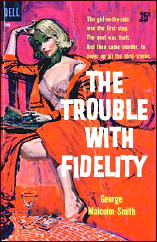
The Nutmeg Indemnity Company employs Lenny Painter to apprehend defalcators unfortunately bonded by that insurance company and to retrieve whatever monies they might have left. In The Trouble with Fidelity, this is going to be a bit difficult, since Homer W. Gillespie has made off with over $500,000 from the Fordyce Management Company and has killed himself.
Nonetheless, Painter begins backtracking, with the aid of Gumbus, the C.P.A. from the district attorney’s office, and O’Brien, an investigator for the D.A., who never thinks, just turns up stones.
Gillespie turns out to have been a much more interesting man than appeared on the surface. His embezzlement is a work of art, though his method of concealing it is a bit less so. Following down the money, Painter goes to Newark, Buffalo, Detroit, Boston, and Maine, and discovers some surprising information about Gillespie.
While the ending is implausible, what leads up to it is excellent. Not a great mind, Painter’s, but he’s very good at what he does.
When in The Lady Finger the Massasoit National Bank & Trust Company of Boston is robbed of $200,000 during a well-planned heist, claims investigator Otis Minton is sent to that city to pursue the investigation in the hope that at least some of the funds that the Nutmeg Indemnity Company has had to payout can be recovered.
Although usually one or more steps behind the FBI in their pursuit of the bank robbers, Minton does have one advantage — the lady finger of the title. It seems the robbers, for reasons uncertain, had doused her boyfriend, a hairdresser, with peroxide and placed him under the hair dryer, which did him no good at all. She is miffed, and the reward offered by Indemnity is an added attraction.
Again Malcolm-Smith has produced an amusing and lively novel.
— From The MYSTERY FANcier, Vol. 11, No. 4, Fall 1989.
Bio-Bibliographic Data:
GEORGE MALCOLM-SMITH, GEORGE, 1901-1984. Living in Connecticut in 1950s; editor of an insurance company periodical. [Taken from the Revised Crime Fiction IV, by Allen J. Hubin.]
The Square Peg (n.) Doubleday 1952. Reprinted as Mugs, Molls and Dr. Harvey, Graphic #104, pb, 1955.
The Trouble with Fidelity (n.) Doubleday 1957.
If a Body Meet a Body (n.) Doubleday 1959.
The Lady Finger (n.) Doubleday 1962.
Come Out, Come Out (n.) Doubleday 1965.
Malcolm-Smith also has a short page on Wikipedia, where it is said that “George Malcolm-Smith was an American novelist and jazz musicologist. A 1925 graduate of Trinity College, he hosted a jazz radio program on WTIC-FM in Hartford, Connecticut for many years.”
Mon 22 Nov 2010
REVIEWED BY WALTER ALBERT:
ELIZABETH IRONSIDE – The Art of Deception. Felony & Mayhem Press, 1st US edition, softcover, 2009. Originally published in England by Hodder & Stoughton, hardcover, 1998.
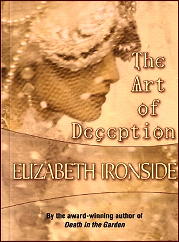
I can’t help but begin with the American publishers’ statement that the books they publish in the “British” category “feature the highly literate, often witty prose that fans of British mystery demand.”
I hadn’t realized that this was why I read a fairly substantial number of British mysteries, but I will preen my feathers discreetly, trying to pretend that I’m not flattered by the claim.
To give you some idea of author’s style, here are the opening lines:
“The mind of a killer is a fascinating study.” Prisca remarked.
She was eating a trout, concentrating on piercing its crisply fried skin, slicing along its back and separating it into fillets, having already removed its head. She was the sort of vegetarian who, some how, categorises fish among plant life.
The first-person narrator of this archly comic mystery is Nicholas Ochterlonie, a prim art historian who, suddenly abandoned by his wife, finds himself afloat on a sea of uncertainty. The comforting, safe harbor he thinks he finds in his neighbor, the beautiful and mysterious Julian Bennet, instead turns out to be the beginning of a perilous voyage.
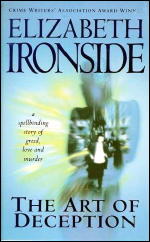
It’s initially one of discovery, with the often remote yet sometimes passionate Julian alternately exciting and perversely frightening him. The trashing of Julian’s flat by vandals and a street mugging introduce dark notes into the world he marginally shares with her, and her friends, Russians of dubious background, he only tolerates because he hopes they will bring him closer to an understanding of the enigma that she remains to him.
There’s deception at every level in this artful novel. Nicholas is, of course, undoubtedly deceiving himself as he is deceived by Julian, but prodded by his cousin Prisca at the opening dinner, the novel is his attempt to follow her advice to “come to some kind of understanding of what happened, why it happened, why it happened to you of all people.”
The reader floats on a surface of contradictions and improbable events, with the novel, in search of explanations, ending with the narrator’s declaration that he will “never tell [Prisca] or anyone” what they want to know.
And if you are interested in learning more about the the multiple deceptions, I invite you to enter this maze, perhaps at your own peril.
Bio-Bibliography:
A Very Private Enterprise (1984)
The Accomplice (1995)
Death in the Garden (1995)
The Art of Deception (1998)
A Good Death (2000)
Elizabeth Ironside is/was the pen name of Lady Catherine Manning, wife of Sir David Manning, the British ambassador to the US between 2003 and 2007. Felony & Mayhem Press has recently reprinted all five books, in each case their first US publication.
Sun 21 Nov 2010
THE ARIZONIAN. RKO Radio Pictures, 1935. Richard Dix, Margot Grahame, Preston Foster, Louis Calhern, James Bush, J. Farrell MacDonald, Willie Best, Etta McDaniel. Director: Charles Vidor.

The ruggedly handsome Richard Dix, the actor whose voice you could recognize at a hundred paces, maybe even a thousand, was – and I’d never realized it until watching The Arizonian a couple of evenings ago – an occasional but fairly popular western star in the 1930s and 40s.
He was the star of Cimarron (1931) for example; he was in this movie, of course; and he played Wild Bill Hickok in Badlands of Dakota (1941) and Wyatt Earp in Tombstone: The Town Too Tough to Die (1942).
But unless you can tell me otherwise, most of his films were B-movies, where I think his good looks and great voice were underutilized, if not wasted. Regarding his voice, and I promise I won’t bring it up again, his career in the movies in the 1920s was extensive, and in the silents, all he had was his looks and (in my opinion) some acting ability.
Dix plays Clay Tallant in The Arizonian, the Good Guy who comes to town, a town run by a crooked sheriff – there is a marshal (J. Farrell MacDonald), but he (the marshal) lasts about a minute and a half in terms of on-screen time.
Clay is tempted into staying on by the beauty of singer Kitty Rivers (Margot Grahame), not realizing that his brother, already in town, is deeply in love with her. Brought in by the sheriff (crooked, if you recall, and played to perfection by a nicely supercilious Louis Calhern) is notorious outlaw Tex Randolph (Preston Foster), who soon changes sides when he sees who he’s been brought into town to kill.
All the right ingredients for a pretty good western, and a beautifully photographed one to boot, but that’s all it is, pretty good. There’s a noticeable lack of continuity between scenes — or jumps in the story line, to make myself clearer — that I found annoying. Not a matter serious enough to stop watching, but nonetheless … annoying.
There is a terrific shootout at the corral at the end of town, though, one with few survivors left standing, and one which made me bring the back of my right hand to my forehead with enough force behind it to make me say Duh. Mostly to myself, but now you know too.
Sun 21 Nov 2010
A 1001 MIDNIGHTS Review
by George Kelley & Marcia Muller:
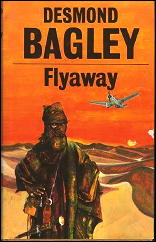
DESMOND BAGLEY – Flyaway. Doubleday, US, hardcover, 1979; Fawcett, paperback, 1980. British editions: Collins Crime Club, hc, 1978. Fontana, paperback, 1979. Reprinted many times since, in both hardcover and soft.
Picking the best Desmond Bagley high-adventure novel is difficult because they are of uniformly high quality; most critics agree that in the past ten years, Bagley has surpassed the old masters such as Hammond Innes and Alistair MacLean with such expert novels as The Vivero Letter (1968), set in the remote Mexican jungle; The Snow Tiger (1974), a tale of an avalanche in the mountains of New Zealand’s South Island; and The Enemy (1978), which deals with computer technology.
Bagley’s novels mix carefully researched background detail with a great deal of action and momentum, involving his reader thoroughly in his adventurous plots.
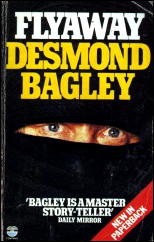
Flyaway may be Bagley’s finest work, a slight cut above the others. When Paul Billson disappears into the Sahara Desert, aircraft-industry security chief Max Stafford departs London for Africa to track Billson down. Max learns that Billson, whose father was a legendary there some decades ago, intends to clear the Billson name; the public still believes Billson’s father deliberately vanished over the Sahara so his wife could collect a fortune in insurance benefits.
Max catches up with Billson — after much difficulty — but then both men find themselves hunted by forces intent on protecting the secret of Billson Sr.’s disappearance.
This novel is superior high adventure; Bagley’s attention to technical detail and his evocation of the desert milieu are impeccable. Bagley drew upon personal experience in the aircraft industry for this novel, which gives it added substance and credibility.
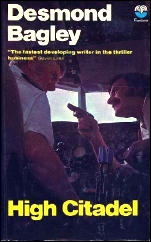
———
Reprinted with permission from 1001 Midnights, edited by Bill Pronzini & Marcia Muller and published by The Battered Silicon Dispatch Box, 2007. Copyright © 1986, 2007 by the Pronzini-Muller Family Trust.
Editorial Comment: Included in Mike Ripley’s list of favorite thrillers was Desmond Bagley’s High Citadel, while David Vineyard, in his Century of Thrillers list suggested either High Citadel, once again, or Running Blind as high points in Bagley’s career.
Fri 19 Nov 2010
REVIEWED BY DAN STUMPF:
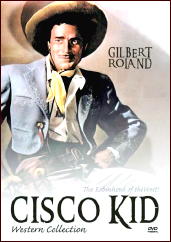
THE CISCO KID WESTERN COLLECTION:
â— THE GAY CAVALIER. Monogram Pictures, 1946. Gilbert Roland, Martin Garralaga, Nacho Galindo, Ramsay Ames, Helen Gerald, Tristram Coffin. Director: Willliam Nigh.
â— BEAUTY AND THE BANDIT. Monogram Pictures, 1946. Gilbert Roland, Martin Garralaga, Frank Yaconelli, Ramsay Ames, Vida Aldana. Director: William Nigh.
â— SOUTH OF MONTEREY. Monogram Pictures, 1946. Gilbert Roland, Martin Garralaga, Frank Yaconelli, Marjorie Riordan, Iris Flores. Director: William Nigh.
â— RIDING THE CALIFORNIA TRAIL. Monogram Pictures, 1947. Gilbert Roland, Martin Garralaga, Frank Yaconelli, Teala Loring, Inez Cooper. Director: William Nigh
â— ROBIN HOOD OF MONTEREY. Monogram Pictures, 1947. Gilbert Roland, Chris Pin Martin, Evelyn Brent, Jack La Rue, Pedro DeCordoba, Donna DeMario. Director: Christy Cabanne.
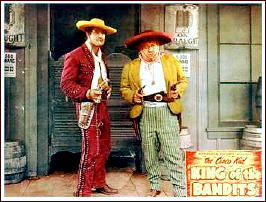
â— KING OF THE BANDITS. Monogram Pictures, 1947. Gilbert Roland, Angela Greene, Chris Pin Martin, Anthony Warde, Laura Treadwell, William Bakewell. Director: Christy Cabanne.
Speaking of Gilbert Roland and Widely Available (as I was at the end of my previous review ), his six Cisco Kid movies from Monogram are out on DVD in pristine prints not seen since their original release. This is not, however, a cause for general rejoicing, as the films themselves could be charitably described as lack-luster.
Gilbert Roland was a romantic leading man in the silent films, but despite his melodious voice and relaxed acting, he slipped badly in the 30s and 40s: he can be glimpsed in humiliatingly small parts in The Sea Hawk (1940) and My Life with Caroline (1941) and he landed in a Columbia serial, The Desert Hawk in ’44.
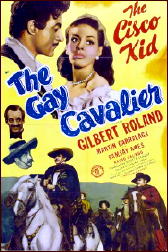
In 1949 John Huston resurrected his fortunes with a meaty part in We Were Strangers that led to a satisfying career as a busy character actor, but in 1946 he was doing pretty much anything that came along — and doing it surprisingly well.
Roland’s Cisco Kid movies have their moments, but they are mostly listless and formulaic. Action is scarce and rather routine (except for a couple of sword fights in The Gay Cavalier and Riding the California Trail) and as for formula, well, in Cavalier Martin Garralaga plays an impecunious rancher who wants to wipe out his debts by marrying his daughter to a shifty Americano. It is up to Cisco to rescue her.
In California Trail, Garralaga plays a rancher in debt to bad guys who wants to absolve his debt by marrying off his niece to a Yankee ne’er-do-well. And in South of Monterey, he’s a Police Captain who owes his job to American bad-guy Harry Woods and pressures his sister to marry him.
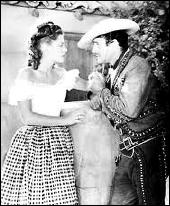
Okay, so there’s a lot of bland-and-predictable in these films, but they are saved, redeemed even, by Gilbert Roland’s swaggering, sexy portrayal of the Cisco Kid. Roland, the only Mexican actor to play Cisco, wrote some of his own dialogue for these films, which demonstrates how seriously he took the part.
His macho swagger and general air of devil-may-care recall Doug Fairbanks in The Gaucho (1927) and even in the reduced circumstances of these poverty-row westerns he looks relaxed, expansive, and damn sexy — which isn’t easy in a B-movie.
Errol Flynn and Clark Gable projected rugged male sexiness easily with the vast resources of Warner Brothers and MGM behind them, but Gilbert Roland somehow managed the same effect on the tiny budgets of a studio renowned in those days as Hollywood’s dumping ground. And somehow he keeps one watching these tawdry films long after their promise has waned.
Fri 19 Nov 2010
Reviewed by DAVID L. VINEYARD:
CROSSPLOT. United Artists, 1969. Roger Moore, Martha Heyer, Claudia Lange, Alexis Kanner, Francis Matthews, Bernard Lee. Screenplay by Leigh Vance, with additional dialogue by John Kruse. Director: Alvin Rakoff.
It was all dressed up like a dog’s dinner. Doesn’t make any sense, any of it.
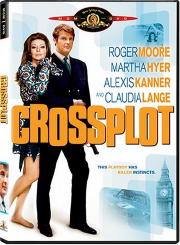
This swiftly paced thriller made between Roger Moore’s stints as the Saint and James Bond is an entertaining exercise in minor Hitchcock with good overall performances and a complex and twisty plot.
Moore is Gary Fenn, a playboy advertising executive in swinging sixties London who finds himself up to his neck in intrigue a la John Buchan when the bad guys have the bright idea to use him to find Marla Kugash (Claudie Lange), a Hungarian model who has overheard an assassination plot at the hands of her aunt, television producer Jo Grinling (Martha Hyer), and assassin Ruddock (Francis Matthews — television’s Paul Temple and a Hammer film regular).
Written by Saint script regulars Leigh Vance and John Kruse (who even wrote some of the non-Charteris Saint novels), and directed by Saint regular Alvin Rakoff, with much of the production crew from the Saint series (which had just wrapped up), this mostly looks like a made-for-television movie with a bit of nudity thrown in, but isn’t bad for that.
The comedy is light, the suspense mild but effective, and there is at least one well done chase (despite some bad back projection) with Moore in a vintage car being pursued across the British countryside by a low flying helicopter.
Despite the made for television look of the film, it has some effective moments when it almost rises above its television roots, and a likable and attractive cast hold it together.
Moore was a natural at this sort of thing, though having just played Simon Templar and soon to do The Persuaders and then James Bond, it’s a bit hard to imagine that he’s any real danger from this lot of conspirators.
Lange proves an attractive and offbeat heroine, and has a nice tasteful nude scene. Hyer is largely wasted in what is little more than the guest villain in a Man From U.N.C.L.E. episode, but Bernard Lee, M in the James Bond films, has a nice villainous turn to class the proceedings up.
Complete with corny, but catchy, theme song, and psychedelic title credits, this is light entertaining fare you will likely feel more affection for than it actually deserves thanks to an attractive cast and low ambitions.
It does exactly what it sets out to do without embarrassing itself, its cast, or the viewers’ intelligence, which is higher praise than many a more ambitious thriller. It’s a lightweight romantic comedy thriller, and that’s all it had any ambition to be. You can’t complain too loudly when a film succeeds at exactly what it intended to be, and nothing more.
« Previous Page — Next Page »

